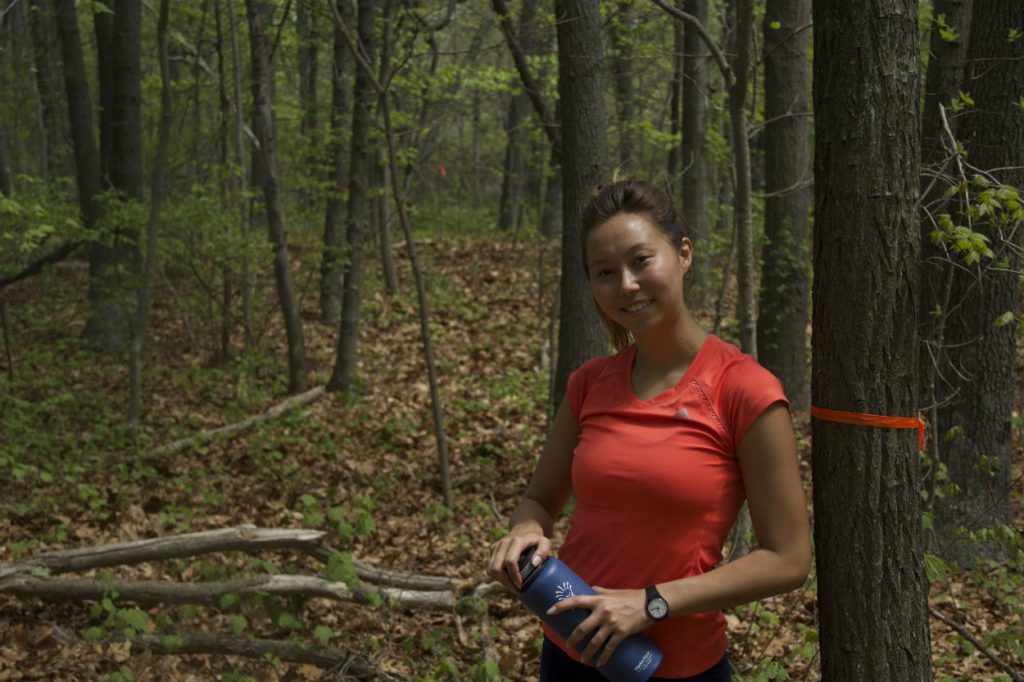Hannah Mellor works at the Lawrence Alloway Memorial Art Gallery in Stony Brook University’s Melville Library, sitting at a desk just inside the gallery door. During her shifts, she has enough time to do some homework, but every time she looked up from her books, she said, what she saw was both beautiful and depressing.
One exhibit this semester included metal birds in cages hanging from the ceiling with the birds’ wings outstretched as if they were trying to fly. In another, logs lay haphazardly at the bottom of a mock hourglass as if time were running out.
Outside, the world was bright and hot, but down in the woods-in the shade underneath the trees–it was much cooler. Mellor moved through the shrubs and the baby trees in the woods surrounding Stony Brook, and she was happy. She took out a roll of orange tape and marked several trees along the route of the nature trail she has been planning for the past six months. Several times, she stopped to point out insects or plants along the route. She hauled dead trees into a line as the border for a makeshift path, dusting her hands afterwards. She sweated from the exertion, but she was smiling. Her nature trail project was coming together.
“You know what’s funny?” she said after moving a heavy log. “I’m a princess. I go shopping. I get my nails done.” She held up a manicured finger, its nail slightly cracked.
“Where I’m from,” she said, “nobody usually does this stuff.”
The “where” of Mellor’s past is not quite that simple. Mellor, 22, was born in Tokyo, Japan to a Japanese Mother and a British father. She eventually moved to England, and from there to the United States.
After high school, she attended the College of Charleston in South Carolina. In 2012, she transferred to Stony Brook. In between, she took a year off, travelling in Italy from Florence to Sicily. In Charleston, Florence and Sicily, Mellor worked in several art galleries, picking up some knowledge of art history along the way.
“The artwork was so colorful, so beautiful and so different than what you see in the gallery over here,” Mellor said, comparing the artwork she saw in Italy and Charleston to what she sees at Stony Brook. “Here, it’s black. It’s always about rape. It’s always something god-awful that happened to somebody.”
“Artwork is a great representative of how people feel,” she added, “and it’s no coincidence that Stony Brook has the saddest students that I’ve ever seen.”
But it wasn’t until recently that Mellor began to consider her trail project a piece of art.
“Yeah, it’s a frickin’ art piece,” Mellor said, grinning wildly. “I never thought of it that way. I always thought it was a community project. But it is an art piece.”
“It is,” she repeated.
That project is no simple undertaking. What started as an assignment in her upper-division Environmental Design, Policy and Planning class has become a community project with over 600 likes on a Facebook page, 40 volunteers and more than 1,500 signatures of support from students and faculty alike.
Students have approached her about adding pieces of art to the trail, she said: An art student wanted to use a piece as a trail marker, and an engineering student wanted to build a swing along the trail.
All this is far from her initial proposal, which included a sprawling map of a trail that wound its way from the reservoir lake next to Mendelsohn Quad, through the Ashley Schiff Park Preserve, south across campus toward the South P lot, and north, finally, up towards West Apartments and the other reservoir near the train tracks.
Other students in the class and her professor, Dr. Harold James Quigley Jr., told her that the plan had real-world application and was actually doable.
Apparently, that was all the incentive Mellor needed.
She started her crusade by talking to Jay Souza, the director of campus recreation, and Susan Dimonda, the associate dean and director of student life. “They liked the idea, but they said they couldn’t do it because of safety,” she stated.
Souza was adamant about the safety aspect, fearing students would be unable to get help in the woods if a student was attacked or hurt. “Safety is number one,” he said in an interview. “There’s no way to monitor safety [on the trail]. There’s no structures to support it, and the dangers are very high.”
Since that setback, Mellor has gathered extensive support from students. She has talked to leading members of Friends of the Ashley Schiff Park Preserve, who showed enthusiastic support for the plan and have allowed Mellor’s trail to connect to the existing trails in the preserve.
“Hannah Mellor is a passionate and articulate advocate for her cause, and the Friends of Ashley Schiff Park Preserve applaud her efforts to create a trail system throughout the naturally forested areas on campus,” Dr. Margaret Conover, the President of Friends of Ashley Schiff Park Preserve, said in an email.
People who meet Mellor for the first time are often struck with how energetic she is, and how driven she is towards her goal.
“She’s a brilliant young woman,” said Quigley, who has advised her on many parts of the project. “I fully expect Mellor is going to succeed, whatever happens.”
Many of the trails that Mellor’s group would employ already exist in some fashion. Especially in the woods on the southern end of campus north of South Drive, many trails end in surrounding back yards. The ground is uneven and full of roots. Old, rotting logs lie across the path.
Senior geology major Dylan McDougall, one of the main movers and shakers of the nature trail project, has been moving such logs from trails since his Boy Scout days.
McDougall met Mellor last fall and has been with the project almost since its conception. “She’s certainly a high achiever, but she’s not solely committed to in-class work,” McDougall said. “With the nature trail, she’s persistent with every single aspect of it.”
Mellor was set to graduate from Stony Brook in May with a degree in Sustainability Studies, and her plans stretched far beyond the nature trail. She wants to work in and eventually run sustainable-development companies. She also hopes to develop urban communities around nature, such that 50 percent of the grounds could be forest or trail. She believes in a balance between practicality and environmentalism.
As graduation loomed, she said, she had been afraid that the project would die with her. But a group has formed to continue the work, and its members plan to set up a club next semester.
“Even if it doesn’t happen this semester, she has left behind a legacy for other students to pick up,” Quigley said.
In the woods, Mellor is gentle to the insects and plants, at least to those that are not getting in the way of her trail and to those who aren’t invasive species. She huddles over a small shrub that is dotted with tiny insect eggs. “Look at this,” she said, “Aren’t they freakin’ beautiful?”
As she works in the forest, her drive is apparent. She is seemingly tireless, even while she struggles and sweats. She talks in a fevered tone. Her brown eyes, the color of bark, glow with excitement.
“I love this,” she said. “I love this so much.”





Comments are closed.